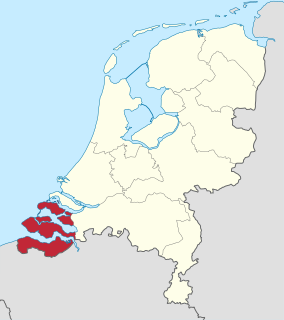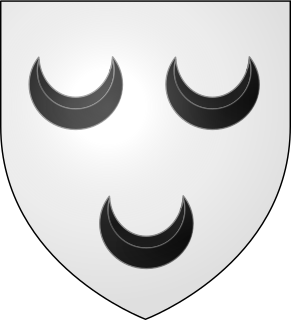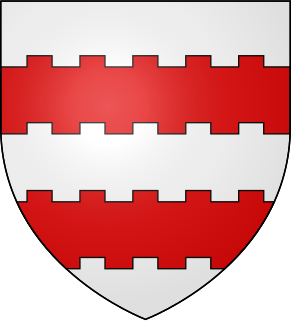
Zeeland is the westernmost and least populous province of the Netherlands. The province, located in the south-west of the country, borders North Brabant to the east, South Holland to the north, and the country of Belgium to the south and west. It consists of a number of islands and peninsulas and a strip bordering the Flemish provinces of East and West Flanders. Its capital is Middelburg with a population of 48,544 as of November 2019, the largest municipality in Zeeland is Terneuzen. Zeeland has two seaports: Vlissingen and Terneuzen. Its area is 2,934 square kilometres (1,130 sq mi), of which 1,151 square kilometres (440 sq mi) is water, and it has a population of 383,689 as of November 2019.

Margaret II of Avesnes was Countess of Hainaut and Countess of Holland from 1345 to 1356. She was Holy Roman Empress and Queen of Germany by marriage to Holy Roman Emperor Louis IV the Bavarian.

The Hook and Cod wars comprise a series of wars and battles in the County of Holland between 1350 and 1490. Most of these wars were fought over the title of count of Holland, but some have argued that the underlying reason was because of the power struggle of the bourgeois in the cities against the ruling nobility.
John of Avesnes was the count of Hainaut from 1246 to his death.
John II was Count of Hainaut, Holland, and Zeeland.

Jacqueline, of the House of Wittelsbach, was a noblewoman who ruled the counties of Holland, Zeeland and Hainaut in the Low Countries from 1417 to 1433. She was also Dauphine of France for a short time between 1415 and 1417 and Duchess of Gloucester in the 1420s, if her marriage to Humphrey, Duke of Gloucester, is accepted as valid.

The County of Holland was a State of the Holy Roman Empire and from 1433 part of the Burgundian Netherlands, from 1482 part of the Habsburg Netherlands and from 1581 onward the leading province of the Dutch Republic, of which it remained a part until the Batavian Revolution in 1795. The territory of the County of Holland corresponds roughly with the current provinces of North Holland and South Holland in the Netherlands.
Albert I, Duke of Lower Bavaria, was a feudal ruler of the counties of Holland, Hainaut, and Zeeland in the Low Countries. Additionally, he held a portion of the Bavarian province of Straubing, his Bavarian ducal line's appanage and seat, Lower Bavaria.

William I, Duke of Bavaria-Straubing, was the second son of Emperor Louis IV and Margaret II of Hainaut. He was also known as William V, Count of Holland, as William III, Count of Hainaut and as William IV, Count of Zeeland.

William II of Bavaria was duke of Bavaria-Straubing and count of Holland, Hainaut and Zeeland. He ruled from 1404 until 1417, when he died from an infection caused by a dog bite.

The Treaty of Delft, also called the Reconciliation of Delft, was signed on 3 July 1428 between Jacqueline of Bavaria and Philip the Good, Count of Flanders and Duke of Burgundy.

Margaret of Bavaria was the duchess of Burgundy by marriage to John the Fearless. She was the regent of the Burgundian Low Countries during the absence of her spouse in 1404–1419 and the regent in French Burgundy during the absence of her son in 1419–1423. She became most known for her successful defense of the Duchy of Burgundy against Count John IV of Armagnac in 1419.

Dirk III van Brederode was lord of Brederode.

Brederode Castle, also called the Ruins of Brederode, is located near Santpoort-Zuid. The castle was founded in the second half of the 13th century by William I van Brederode (1215–1285). William was a descendant of the lords van Teylingen, who were related to the counts of Holland. The castle formed part of the high lordship Brederode, which had been given in loan in the 13th century to the lords of Brederode by the count of Holland.
Willem van Brederode was an admiral-captain and an important partisan of the Hook faction during the Hook and Cod wars.

The battle of Zierikzee was a naval battle between a Flemish fleet and an allied Franco-Hollandic fleet which took place on 10 and 11 August 1304. The battle, fought near the town of Zierikzee, ended in a Franco-Holland victory. The battle is part of a larger conflict between the Count of Flanders and his French feudal lord, King Philip IV of France (1296–1305).

John I, Lord of Egmond was Lord of Egmond, Lord of IJsselstein, bailiff of Kennemerland (1353-1354) and stadtholder of Holland.

John III, Lord of Polanen was Lord of Polanen, Lord of De Lek and Lord of Breda.

John IV, Lord of Arkel was Lord of Arkel from 1326 until his death.

Joost Berman was a Dutch lawyer, judge, politician, poet, nonfiction writer, and editor.
















